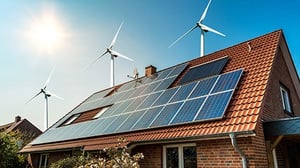 If you had any work done to your home in 2019 that improves its energy efficiency, you may qualify for a residential energy efficient property credit. Consider using this federal credit to reward yourself for making greener choices.
If you had any work done to your home in 2019 that improves its energy efficiency, you may qualify for a residential energy efficient property credit. Consider using this federal credit to reward yourself for making greener choices.
What can you claim?
According to the Internal Revenue Service, the residential energy efficient property credit covers 30 percent of the cost — installation included — of any qualified solar electric, solar water heating, small wind energy, geothermal heat pump or fuel cell equipment you implemented in your home over the previous year. The credit will also cover equipment installed at a second home, which means you can claim the credit on any rental property you might own.
There is no cap on the credit you can reap for solar electric, solar water heating or small wind energy equipment, but there are certain guidelines that must be met. For example, any solar water heating property will only qualify for the credit if it has been certified by the Solar Rating Certification Corporation or similar entity, and any geothermal heat pump equipment must be Energy Star-certified to quality. Qualifying fuel cell equipment must have a capacity of at least one-half kilowatt of electricity and 30 percent or greater electricity generation efficiency, and the credit is capped at $500 for every one-half kilowatt generated by the fuel cell.
What doesn’t count toward an energy tax credit?
According to the IRS, most traditional roofs will not qualify for a residential energy efficient property credit even if the net result is a more efficient home. However, there are exceptions. If your new roof includes solar tiles or shingles that conduct energy for your home, you may qualify for the credit. The IRS also notes that any costs related to swimming pools or hot tubs will not qualify for the residential energy efficient property credit.
How do you get the credit?
To qualify for the residential energy credit, you’ll need to fill out Form 5695, which is available through the IRS website. Line-by-line instructions are provided to help you fill in the form. You can also consult with your tax professional.
Per the IRS, if you have a joint-occupancy home, every occupant of the home will need to fill out a Form 5695. If you are married and filing a joint return, you’ll only need one form.
Upgrading your home to utilize sustainable energy is a smart choice no matter how you slice it. While you’ll pay more up front to take advantage of solar, wind, geothermal or fuel cell technologies, the benefits that you’ll enjoy over the lifetime of your home will more than make up for it. Receiving a larger tax return thanks to the residential energy efficient property credit will help make your investment seem all the more worthwhile, even in the short term. Talk to your tax professional to see if you qualify.